Matt Edwards
Associate Professor of Voice, Shenandoah Conservatory Artistic Director of the CCM Vocal Pedagogy Institute
Mix it up Monday: Empowering students to find their own musical theatre rep
 Finding repertoire is one of the biggest challenges for voice teachers who train musical theatre performers. In the classical world, teachers are often expected to be the ones who find repertoire for the student. This is a reasonable expectation since the classical repertoire has existed for centuries and has remained relatively consistent for the last one hundred years. Yes there are new composers, but the standards still seem to be preferred over new works in most audition situations.
Finding repertoire is one of the biggest challenges for voice teachers who train musical theatre performers. In the classical world, teachers are often expected to be the ones who find repertoire for the student. This is a reasonable expectation since the classical repertoire has existed for centuries and has remained relatively consistent for the last one hundred years. Yes there are new composers, but the standards still seem to be preferred over new works in most audition situations.
The same is not true for musical theatre. While the standards are still performed, new musicals and songs are constantly being written and they are often the best choices for auditions. Furthermore, actor type often matters more than voice type, making the process of picking music even more challenging. Since there is always new repertoire and your student’s type will constantly be changing as they age, the best gift you can give them is a process to pick their own music. By empowering your students to find their own repertoire, you are helping them develop a skill set that will save them hundreds if not thousands of dollars down the road. While their colleagues are always running to a coach to find new audition songs, your students will find their own repertoire and then take the songs to a coach to perfect their package. Here is how the process works.
First, have your student start watching videos on YouTube of musicals and find two to three roles that they think would be a good fit for who they are now. For this example, we are going to imagine that the only role your student is drawn to is Glinda in Wicked.
Now have your student go to The Internet Broadway Database (http://www.ibdb.com). This site lists almost every musical and who played what part. Have your student begin with one of the role(s) she identified. Look the show up on IBDB, click on it, and you will come to the main page for the production.
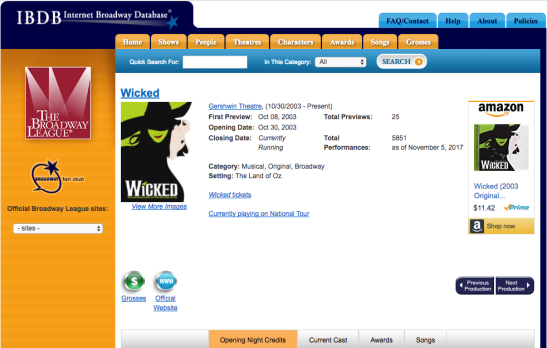
Scroll down to the bottom of the page, and you will find a list of the opening night cast members.
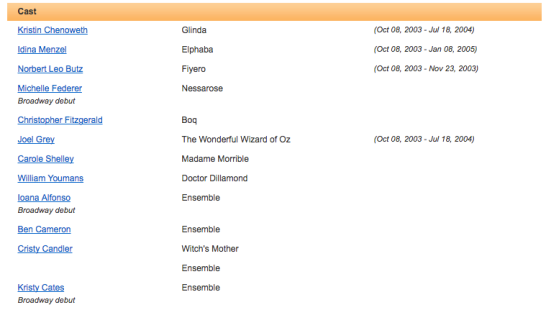
At this point, the student will need to start a spreadsheet. The first column of the spreadsheet should be labeled “Name” and the rest of the columns should alternate between “Show” and “Role.”

Type the name of the actress who debuted the role, the show, and the name of the character. Next, on the IBDB site, click on the actresses name and open the link in a new tab. In this window, you will find a list of every role that actress has played on Broadway.
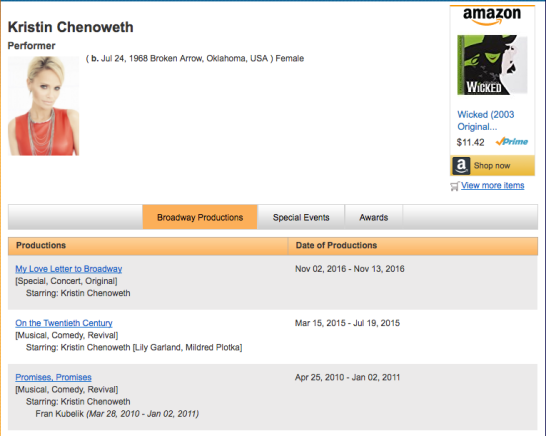
Have your student add all of those roles to her spreadsheet unless the role is clearly too old for her. Now go back to the original tab for the opening night cast, scroll down to the bottom, and you will find a list of understudies. Click on the name of the actress who was the understudy and open the link in a new tab. Add her name and the shows/roles she played.

Now go back to the original tab for the opening night cast, scroll down to the bottom, and click on “Display Replacement and/or Transfer Information” (see above).
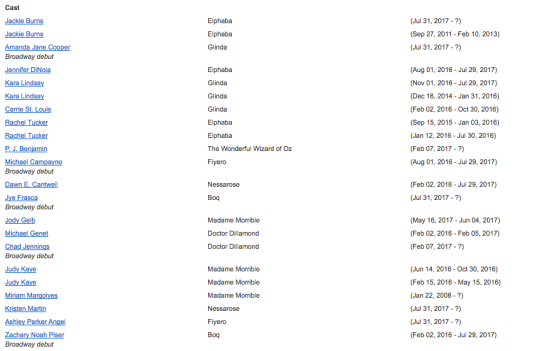
Go through this list, repeating the steps above. If there is limited data on IBDB, search for the actress’ website and read her resume and bio.
By this point, your student should have a spreadsheet that looks similar to this, but hopefully with more names and roles.
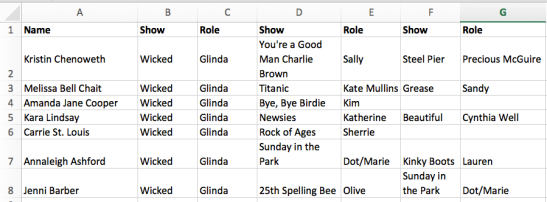
Since IBDB only lists Broadway credits, ask your student to also Google the actresses, find their personal websites, or look the actress up on Wikipedia to see what else she has done Regionally, on Tour, off-Broadway, and in concert.
 By this time, your student should have a great list of possibilities. Now have her go to YouTube and look up each these roles and look for songs that might be a good fit. If she has a membership to MusicalTheatreSongs.com, she could look up each show and get a list of songs by clicking “Song Details” and entering the name of the show. If she has a copy of “The New Broadway Song Companion” she can also find details about what songs the character sings, along with the tempo and range of each song. Have her create a YouTube playlist and share it with you. Now you have a list of songs to choose from that she has compiled. She now has a database that she can continue to develop and a YouTube playlist she can add to at any time. You have now empowered your student to take control of at least one part of her career. Each time you give her a skill that she can develop on her own, you build her confidence and help her take another step towards being a young professional and an independent learner.
By this time, your student should have a great list of possibilities. Now have her go to YouTube and look up each these roles and look for songs that might be a good fit. If she has a membership to MusicalTheatreSongs.com, she could look up each show and get a list of songs by clicking “Song Details” and entering the name of the show. If she has a copy of “The New Broadway Song Companion” she can also find details about what songs the character sings, along with the tempo and range of each song. Have her create a YouTube playlist and share it with you. Now you have a list of songs to choose from that she has compiled. She now has a database that she can continue to develop and a YouTube playlist she can add to at any time. You have now empowered your student to take control of at least one part of her career. Each time you give her a skill that she can develop on her own, you build her confidence and help her take another step towards being a young professional and an independent learner.
Do you have other tips for helping your students find their own songs? If so, please comment below. If you are not already following the blog, you can sign-up at the bottom of this page to get an email every time there is a new post. If you enjoyed this article, please share it on social media. Also, be sure to check out the past posts. As of today, there are now 120 articles all available for free on this blog! As always, thank you for reading and have a wonderful week of teaching! ~ Matt




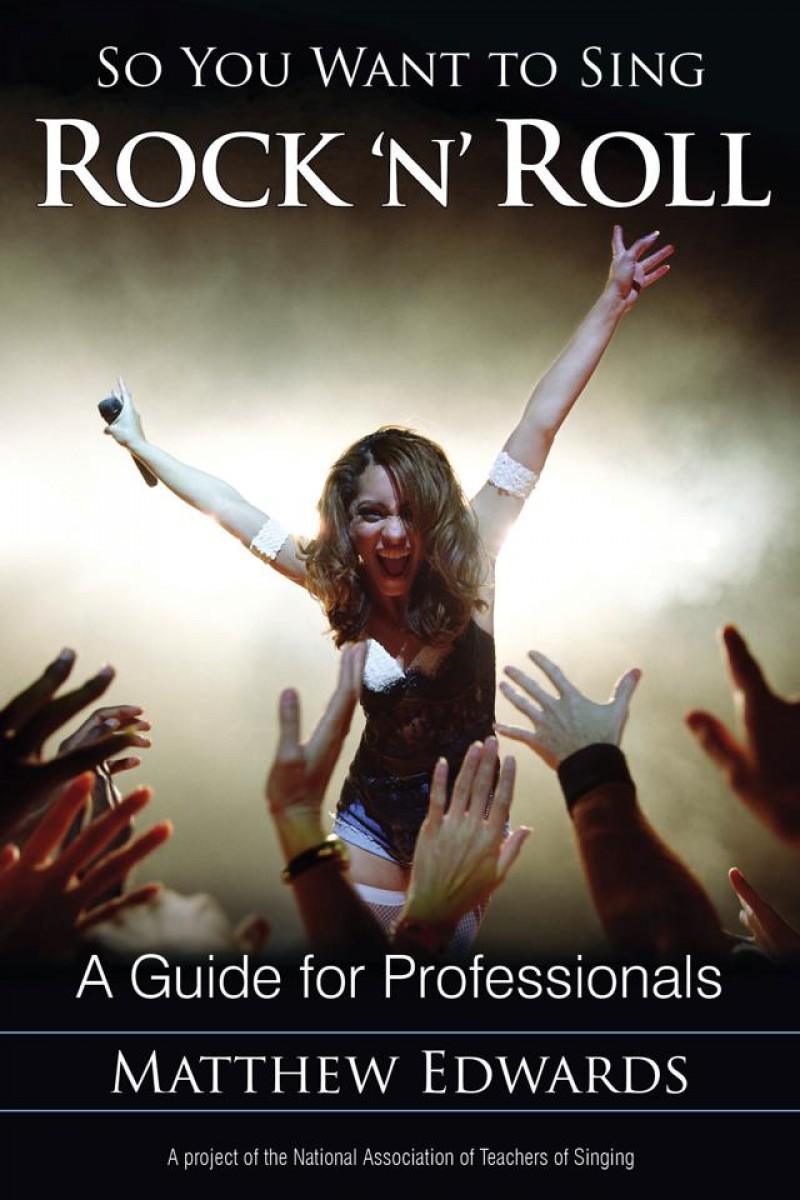
Great post!
LikeLike
THANK YOU SO MUCH!!!!! Love this blog, can’t live without it
From: Matthew Edwards To: mareyzaga@yahoo.com Sent: Monday, November 13, 2017 11:29 AM Subject: [New post] Mix it up Monday: Empowering students to find their own musical theatre rep #yiv1831879972 a:hover {color:red;}#yiv1831879972 a {text-decoration:none;color:#0088cc;}#yiv1831879972 a.yiv1831879972primaryactionlink:link, #yiv1831879972 a.yiv1831879972primaryactionlink:visited {background-color:#2585B2;color:#fff;}#yiv1831879972 a.yiv1831879972primaryactionlink:hover, #yiv1831879972 a.yiv1831879972primaryactionlink:active {background-color:#11729E;color:#fff;}#yiv1831879972 WordPress.com | Matthew Edwards posted: “Finding repertoire is one of the biggest challenges for voice teachers who train musical theatre performers. In the classical world, teachers are often expected to be the ones who find repertoire for the student. This is a reasonable expectation since t” | |
LikeLike
You are welcome! Thanks for reading.
LikeLike
Great post, Matt! I do an assignment in my Intro to MT class called a “Take Home Research” which is a worksheet that has students do just that. They fill out the worksheet. Its called the “Role Models” project!
LikeLike
Another great post Matt! I have a similar assignment that I have my first year students do but since many of them are relatively new to musical theatre, it’s not always as successful as I would like it to be. I’m going to use your method as inspiration to design an assignment for my second year students. Thanks for all of the great suggestions! I look forward to seeing what’s coming every Monday!
LikeLike
You are welcome, thanks for reading and sharing the work!
LikeLike